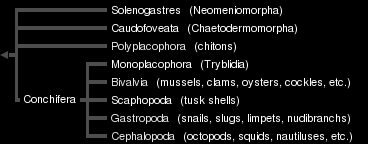Phylum Mollusca
Phylum MolluscaKingdom Animalia |
| |||||||||||||||||||||||
|
Molluscs' development suggest a close ancestral relationship to other protostomes, notably the Annelids, that includes segmented worms. Mulluscs are believed to have appeared near the base of the Cambrian and have left an extensive fossil record of several tens of thousands of species. Science believes Molluscs fully participated in the Cambrian Explosion phenomena, with the appearance and disapperance of many forms, many of which remain undiscovered in the fossil record. Gastropods, Bivalves, and Cephalopods, the major groups of interest as fossils, diversified and specialized into the Ordovician to become ubiquitous throughout marine ecosystems. They adapted with the new selective pressures as other marine life forms similrly expanded, and they became both hunter of and hunted by new forms. The fossil record attests to the bivalves adapting to fresh water environments in the Devonian, as well as the appearance of land-based Gastropods in the Carboniferous. The ammonites particularly flourished throughout the Mesozoic before going extinct in the K-T event along with the dinosaurs.
Notes:
|
||||||||||||||||||||||||
Fossil
Museum Navigation:
Home Geological Time Paleobiology Geological History Tree of Life Fossil Sites Fossils Evolution Fossil Record Museum Fossils |

 Phylum
Mullusca is both large and diverse. Molluscs comprise the familiar
animals commonly known for both their shells and fine seafood,
including snails, clams, octopus and squid.
Phylum
Mullusca is both large and diverse. Molluscs comprise the familiar
animals commonly known for both their shells and fine seafood,
including snails, clams, octopus and squid.